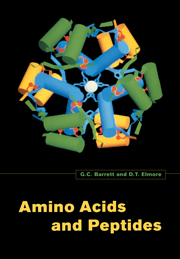Book contents
- Frontmatter
- Contents
- Foreword
- 1 Introduction
- 2 Conformations of amino acids and peptides
- 3 Physicohemical properties of amino acids and peptides
- 4 Reactions and analytical methods for amino acids and peptides
- 5 Determination of the primary structure of peptides and proteins
- 6 Synthesis of amino acids
- 7 Methods for the synthesis of peptides
- 8 Biological roles of amino acids and peptides
- 9 Some aspects of amino-acid and peptide drug design
- Subject index
7 - Methods for the synthesis of peptides
Published online by Cambridge University Press: 05 June 2012
- Frontmatter
- Contents
- Foreword
- 1 Introduction
- 2 Conformations of amino acids and peptides
- 3 Physicohemical properties of amino acids and peptides
- 4 Reactions and analytical methods for amino acids and peptides
- 5 Determination of the primary structure of peptides and proteins
- 6 Synthesis of amino acids
- 7 Methods for the synthesis of peptides
- 8 Biological roles of amino acids and peptides
- 9 Some aspects of amino-acid and peptide drug design
- Subject index
Summary
Basic principles of peptide synthesis and strategy
The synthesis of a dipeptide, CHR1CONHCHR2COO-, from the constituent amino acids involves forming the peptide bond so that the amino-acid sequence is correct and enantiomerisation (Section 7.7) at the chiral α-carbon atoms is avoided. The latter point does not arise, of course, with glycine. In order to produce the correct sequence and to prevent the formation of a mixture of higher peptides, the amino group of the intended N-terminal residue and the carboxy group of the intended C-terminal residue are normally protected.
In the synthesis of higher peptides, the polypeptide chain can be built up one unit at a time in either direction. For example, an octapeptide could be synthesised in several stages proceeding through a dipeptide, a tripeptide, a tetrapeptide and so on. Alternatively, the octapeptide could be formed from two tetrapeptide units (fragment condensation), which in turn might be built up one unit at a time or formed from two dipeptides. Apart from chemical considerations, the overall yield would depend on the route selected. For example, if the synthesis of each peptide bond could be achieved with a yield of 80%, the stepwise procedure of adding one amino-acid residue at a time would give an overall yield of 21% relative to the first two amino acids used. In contrast, the synthesis which proceeds through four dipeptides to two tetrapeptides and thence to the octapeptide would give an overall yield of 51%.
- Type
- Chapter
- Information
- Amino Acids and Peptides , pp. 130 - 173Publisher: Cambridge University PressPrint publication year: 1998
- 1
- Cited by



